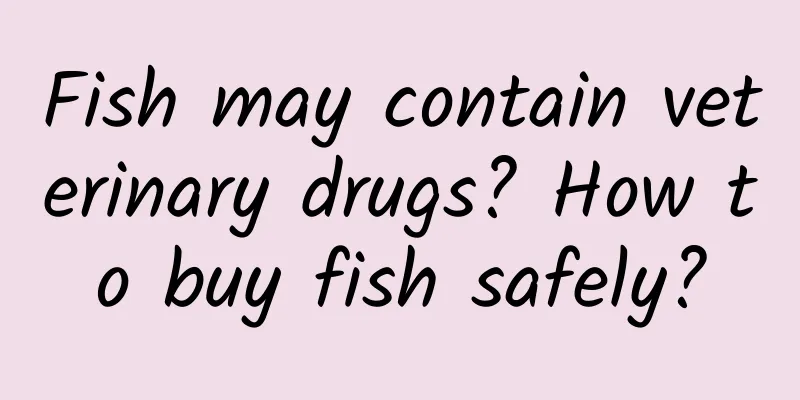Fish may contain veterinary drugs? How to buy fish safely?

|
Produced by: Science Popularization China Author: Denovo Team Producer: China Science Expo Food is a basic physiological need of people. Now that material wealth is extremely abundant, people’s demand for food has changed from simply “to eat enough” to “to eat well”. Among many ingredients, fish has always been a favorite on people's tables because it is rich in protein, vitamins, lecithin and a variety of mineral elements that are beneficial to the human body. However, recently, the food safety sampling data released by the market supervision bureaus in some places showed that the fish that we often see on the table, such as carp and Qingjiang fish, were found to contain excessive veterinary drugs, which has caused people to have deeper concerns about food safety issues. Steamed fish (Image source: pixabay) Why do we need veterinary drugs in fish farming? Just as the scientific and rational use of fertilizers and pesticides can increase crop yields, farmers also use veterinary drugs to improve fish quality and increase breeding efficiency. Fish farming (Image source: pixabay) Veterinary drugs used in fish farming can be roughly divided into two categories: one is hormone veterinary drugs, and the other is antibacterial veterinary drugs. Hormone veterinary drugs are usually consumed by fish as feed additives and can be divided into peptides, peptide derivatives, sterols and steroids. They promote the growth and development of animals and cause them to gain weight rapidly. At the same time, the intake of adrenergic receptor agonists in hormone veterinary drugs by fish can also significantly improve the meat quality of aquatic products, that is, the ratio of fat to lean meat. Therefore, adding hormone veterinary drugs will make fish meat more firm, thereby improving the economic benefits of farmers. my country has a set of strict standards and management systems for the use of hormone drugs in aquatic products. Currently, there are only more than 30 types of hormone drugs approved for use in aquatic products, and detailed regulations are given on usage, dosage, withdrawal period and other precautions. Antimicrobial veterinary drugs are mainly divided into two categories: one is antibiotics or antimicrobial substances, which are usually the products of microorganisms in the metabolic process. Even if the amount used is very small, it can inhibit or eliminate pathogenic microorganisms. In aquatic products, tetracycline, amide alcohols and aminoglycosides are more commonly used. The other is synthetic drugs with antibacterial effects. This type of drug can also kill pathogenic microorganisms and expel parasites, and plays a vital role in the treatment of animal diseases. drug (Image source: pixabay) What are the hazards of veterinary drug residues? Although the rational use of veterinary drugs can ensure the healthy growth of fish, the presence of veterinary drug residues in fish has become a common problem due to various reasons. This residue mainly comes from individual farmers not complying with the regulations on the use of veterinary drugs, such as illegally adding and abusing veterinary drugs in feed, or using antibiotics to cover up the symptoms of sick fish before selling the products, resulting in excessive veterinary drug residues. When people eat fish containing veterinary drug residues, the drugs will enter the human body and pose a threat to human health. If antibiotics accumulate in the human body to a certain amount, the body will develop drug resistance to certain fungi, which will affect the effectiveness of subsequent use of antibiotics to treat bacterial infections. At the same time, consuming a large amount of food with excessive antibiotics will disrupt the balance of the human intestinal flora and may lead to infectious diseases. Hormone drug residues may cause endocrine disorders in the human body, which is particularly harmful to children and may lead to precocious puberty, developmental abnormalities and obesity. What should I pay attention to when buying fish? As consumers, although we cannot personally participate in the fish farming process, we can use some techniques to reduce the possibility of selecting unqualified fish and choose fresh and safe fish as much as possible. If you are buying live fish, you need to pay attention to the fish's breeding environment. If the water is turbid and full of dark green algae and other substances, then this may be a warning sign and we should prefer fish raised in clear water. For frozen or dead fish, you need to check the color of the fish meat. The normal color of fish meat is white with a hint of red. If the fish meat is too white or too red, it may be that pigments have been added. In addition, checking the eyes and gills of the fish is also a good method. The eyes of fresh fish usually look clearer and the gills are brighter red. Selling fish in the market (Image source: pixabay) Conclusion my country has always attached great importance to food safety management, and has issued a series of regulations and management systems, and has also carried out many special rectification actions on aquaculture drugs. However, ensuring food safety is still a very difficult task. The irregular use and excessive use of veterinary drugs by individual farmers may still lead to excessive drug residues, which in turn affects the health of consumers. "Safety on the tip of the tongue" is related to everyone's health. I believe that with the support of the country, food safety supervision and testing will continue to develop, and food safety issues will receive greater attention to minimize the occurrence of problems. References: [1] Li Tianyong, Liu Bin, Zhang Bo. Current status and detection research prospects of veterinary drug residues in aquatic products[J]. Science and Technology Outlook, 2016, 26(15). [2] Ganai Yasen. Common types of illegal veterinary drugs and their hazards[J]. Animal Husbandry and Feed, 2019(8):2. [3] Wang Dongxing, Lei Rui, Shi Jingya. Types and detection techniques of veterinary drug residues in food[J]. Food Safety Guide, 2022(23):159-161. [4] Shao Mingyang. Hazards of veterinary drug residues and monitoring strategies[J]. Chinese Journal of Veterinary Drugs, 2003, 37(2):4. |
<<: Musk becomes the world's richest man, is the secret the "first principles"?
>>: [Smart Farmers] How to create a "home botanical garden" on the balcony?
Recommend
Lose! Hair! Can! Cure! See if you belong to this 90%, come and check your name...
The receding hairline, the piles of hair that I p...
Android 12 new version details: follow iOS 14 to improve user privacy experience
Some developers have found that in the new versio...
How to create the Maoming WeChat Mall mini program? How to operate a mini program mall?
After developing e-commerce mini programs, many b...
5 Conversion Rate Optimization Strategies for SaaS Products!
For the conversion rate of SaaS products, every o...
Baise Moving Mini Program investment price inquiry, how much is the Baise Moving Mini Program investment price?
What is the investment cost of Baise Moving Mini ...
How to deal with the H1N1 flu outbreak? Is it too late to get vaccinated now?
Although everyone has made some preparations to d...
"Sun God Clothes" are here! Chinese universities develop 24-hour constant temperature smart clothing, it's so cool
This winter is too cold. On December 16, the Cent...
How to salvage a screwed holiday marketing campaign
How to make holiday marketing most effective in t...
How should educational companies acquire customers on Kuaishou?
2019 was a "winter period" for the educ...
Surface Pro 4 will be available next year, with a 3-fold increase in speed
According to foreign media reports, Microsoft and...
Why does Taobao require us to play games?
After ten years of exploration, the growth of Tma...
Hawthorn yogurt exported to the United States is labeled with a "cancer warning". Is this snack still edible?
Recently, in a hotly circulated content, a big &q...
Why are pig ears and chicken cartilage so delicious?! Really delicious warning
Let’s do a little survey first to see how many pe...
Wandoujia opens up a new way to discover personalized content
Wandoujia, China's most popular and active &q...
Review | 10 distribution pitfalls encountered in course activities, 8 key links of screen-sweeping
After reviewing the distribution course activitie...









